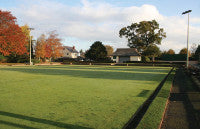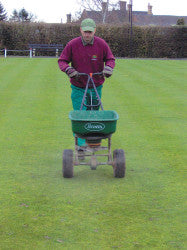Spring maintenance of bowling greens 2009
The onset of the bowls playing season usually begins in March when favourable weather, soil and air temperatures begin rising above 10 degrees C, thus encouraging and stimulating grass growth.
 It is during March and early April that spring renovations are carried out to prepare the greens for the forthcoming playing season. The main objective for the greenkeepers is to provide a consistent playing surface.
It is during March and early April that spring renovations are carried out to prepare the greens for the forthcoming playing season. The main objective for the greenkeepers is to provide a consistent playing surface.
The first operation is to firm up the greens, particularly after a period of frosts, when the ground has been lifted. This is carried out by rolling the green using a mower in the disengaged mode (no cylinder blades working) walking slowly in several directions over the surface of your green. Subsequent rolling can be carried out using a 50kg weight roller.
When rolling, think of a clockface; the first run starting at 12 o'clock and finishing at 6 o'clock.Then starting at 3 o'clock and finishing at 9 o'clock. Work around the clock when conditions allow, not when the soil is saturated or frosted. Ideally, perform this operation when the surface is drying out and the sub surface is moist. This will help firm the playing surface.
A programme of surface aeration is beneficial, particularly to help drain away any surface water or address any surface compaction resulting from recent rolling activities. This can be achieved using a Sarrel Roller or a set of micro tines attached to a pedestrian mechanical spiker.
Most of the deeper aeration works should have been completed during the winter months, i.e. November to February.
Try to avoid the use of slit tines during the spring and summer as these types of aerators can lead to surface disruption, affecting playability. If you need to aerate during the playing season use solid tines.
Once growth has picked up, you may need to apply a dressing of lawn sand. This will help check any moss growth that has accumulated during the winter months. This should be carried out prior to any scarification work being undertaken. The moss should either turn black in colour or be visibly dead prior to raking/scarification procedures.
A programme of light scarification works, using verticutting reels or dedicated scarifying machines set at a shallow depth, can be implemented in spring to remove any debris.
Daily brushing and switching should continue to keep the greens clean and remove any early morning dew. Keeping the sward dry, particularly in the spring, helps minimise the likelihood of any disease attacks.
 Worm activity will increase as the soil temperatures begin to rise and the soils remain moist. It may be necessary to apply an approved product to control worm activity.
Worm activity will increase as the soil temperatures begin to rise and the soils remain moist. It may be necessary to apply an approved product to control worm activity.
Ideally, you should have carried out a soil analysis to establish the nutrient status and pH of your green. The results of this test will help you determine an effective fertiliser programme for the coming year.
Mowing
Mowing is one of the most important practices and should be carried out on a regular basis. Cutting frequencies will depend on the weather and groundc onditions. During the playing season, March to October, the greens should be cut at least three times a week, if not daily.
Machines should be at least 7 to 9 bladed cylinder mowers that are well maintained and sharp. Height of cut will range from 3.5mm to 5mm during the playing season.
A by-product of healthy grass growth is the build up of thatch. In the past this was only ever removed during spring and autumn renovations. However, with the invention of verticutting units and thatch reels, scarification can be carried out on a more regular basis (fortnightly), thereby preventing thatch build up.
Aeration
All grass swards are grown on soil/s and profiles that provide the appropriate environmental structure for plant growth. This growing medium is made up of minerals, organic material and soil pores (water and air). Maintaining the correct balance of these components is critical for sustaining healthy plant growth.
However, the main contributing factor that reduces and damage spore spaces in soil is compaction caused by compression forces normally associated with play and use of machinery, particularly during wet weather periods. Over time these compression forces reduce the pore spaces so that air, water and nutrient flow through the soil profile is restricted, thus leading to many problems associated with compaction.
Aeration will reintroduce air into the soil profile by mechanical means.
Fertiliser
 A planned fertiliser programme should be implemented. Ideally, a soil analysis should have been carried out to ascertain the nutrient status of your soil. Once known, an effective NPK fertiliser programme can be applied to maximise plant growth.
A planned fertiliser programme should be implemented. Ideally, a soil analysis should have been carried out to ascertain the nutrient status of your soil. Once known, an effective NPK fertiliser programme can be applied to maximise plant growth.
Fertilisers come in both granular and liquid forms. It is important to understand how these products work and how to apply them. If indoubt leave it to a professional company to do it for you.
Many greens are damaged and affected by poor fertiliser applications, using the wrong product or over or under dosing. This often leads to visual and physical problems on the surface.
Irrigation
Most, if not all, professional sporting facilities have irrigation systems of one sort or another. Without them they would not be able to prepare and maintain their playing surfaces.
Irrigation is essential for plant survival and growth, soil formation and strength, playability and presentation. Water is influential in all chemical, physiological and biological processes of plant growth.
The soil/plant waterrelationships are critical to the sustainability of any grass plant. Therefore, it is essential that greens are watered during dry periods to sustain grass growth.
Many clubs do have access to water and, in the main, probably keep their greens watered using a hose and sprinkler system.
Care should be taken to ensure the green is watered uniformly and to adequate depth.
Renovations
 Renovations are generally carried out at the end and beginning of the playing season. End of season renovations help rejuvenate the playing surface after a long hard season of wear and tear, with the main emphasis on restoring levels and repopulating grass species. It usually begins with a heavy scarification of the playing surface to remove thatch debris and provide a key for new rootzone materials, followed by topdressing to restore levels, then overseeding.
Renovations are generally carried out at the end and beginning of the playing season. End of season renovations help rejuvenate the playing surface after a long hard season of wear and tear, with the main emphasis on restoring levels and repopulating grass species. It usually begins with a heavy scarification of the playing surface to remove thatch debris and provide a key for new rootzone materials, followed by topdressing to restore levels, then overseeding.
Once this work has been completed the green is usually fertilised to help promote and sustain grass growth throughout the winter period.
Spring renovations are carried out to rejuvenate and prepare the green for the forthcoming season.
Other activities
Other than the main core activities mentioned above, there are several other tasks or activities that can be implemented during the playing season.
These will include:
- Keeping the surface clean andfree of debris and otherextraneous materials, possibleuse of wetting agents to preventdry patch forming and helpimprove soil moisture contents.
- Keeping drainage ditches cleanand safe.
- Maintaining hedges and boundary fence lines.
- Maintaining flood light columnsand lights.
- Maintaining shelters ands eating features around clubhouse.
- Servicing mowers and machinery.
